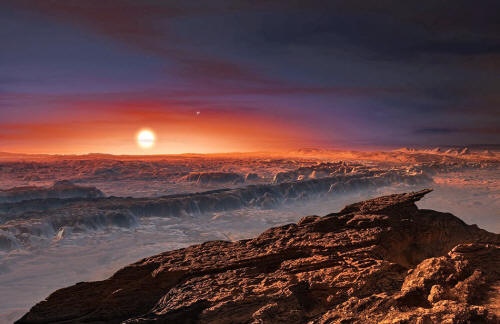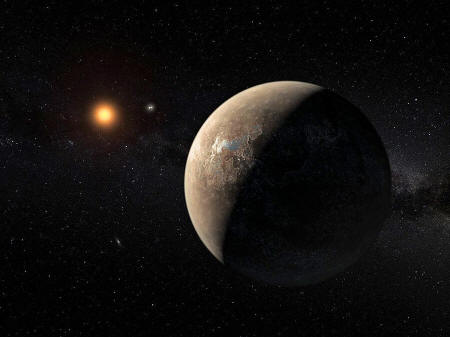|
from BusinessInsider Website
the planet Proxima b orbiting the red dwarf star Proxima Centauri, the closest star to the Solar System.
ESO/M. Kornmesser an Earth-like planet orbiting our sun's nearest neighbor - and it's our best chance (so far)
of finding alien life.
On Wednesday, an international team of scientists in the Pale Red Dot campaign announced that the closest star to our solar system might just be our best bet at finding alien life.
The star, called Proxima Centauri, is a cool, dim red dwarf four light years away.
It's a thousand times fainter than the sun and impossible to see with the naked eye.
Using data from European Southern Observatory (ESO) facilities and other telescopes, the scientists, led by Guillem Anglada-Escudé at Queen Mary University, picked up a small, potentially rocky planet, called Proxima b, that's slightly more massive than Earth.
The team had been looking for a,
The findings (A Terrestrial Planet Candidate in a Temperate Orbit around Proxima Centauri) were published in Nature on Wednesday.
Smack in the middle of the habitable zone
Proxima b is about 4 million miles away from the star (5% of the distance between the Earth and the sun) and completes its orbit every 11 days.
That's much closer than Mercury is from the sun, but because Proxima Centauri is so cool and dim, the planet's location puts it smack in the middle of its habitable zone, which means it has a temperature that might allow for liquid water.
Because the system is so close, upcoming generations of large, ground-based telescopes and dedicated space missions will be able to directly image the planet and glean things like atmospheric composition and possibly even signs of life from the little light they detect.
Although Michael Endl is not directly involved in the study, he had a personal stake in the star system. From 2000 until 2008, Endl and a team of other astronomers investigated Proxima Centauri.
It was this research that helped scientists confirm the existence of Proxima b.
Mean red dwarfs
An artist's impression of Proxima b orbiting Proxima Centauri. ESO/M. Kornmesser
Proxima Centauri, like other red dwarfs, is an active star, and the scientists had to be careful because its ever changing brightness could fake the existence of a planet.
But the signal, Endl said, is like clockwork - it should always be there.
So a huge component of this discovery was to show that the planetary signal is constant and present in all of Proxima Centauri's data, because the planet and orbit of the planet don't change.
When the scientists combined data collected from the Pale Red Dot campaign with earlier observations, they found a clear signal of the intriguing planet.
Day and night
The planet is likely tidally locked to the star, which means the same side is always facing the star.
That means that one side is in eternal darkness and one side is in eternal daylight.
Originally, systems like this were not considered good places to look for Earth-like planets because scientists thought their atmospheres would be heated so much that any water on the daylight surface would boil off, and the night side would be so cold that the atmosphere would freeze it.
But according to Endl, modern 3-D climate models have shown that this is not the case. That's because heat can be transported between the two sides.
Earth-like or not?
The planet's mass, equal to about 1.3 Earths, suggests that the planet is terrestrial, which means it's rocky and has a surface.
That's good news for the hunt for alien life. But scientists can't really say whether the planet is Earth-like just yet because they don't know if it has an atmosphere or liquid water.
The planet would also be more vulnerable to ultraviolet and X-ray flares from the star, and scientists still don't know if it has a magnetic field to protect it from these high-energy charged particles.
According to Ansgar Reiners, a Pale Red Dot collaborator at the Institute of Astrophysics, these factors depend entirely on the formation and early history of the planet, which scientists don't know much about just yet.
Scientists have a lot of work to do before they can say for sure if this planet is Earth-like, and it will be even trickier to find out if it's home to alien life - something we've yet to confirm on any other planet.
The 'long, steep road ahead'
Scientists are already pushing forward, trying to find out if the planet transits directly in front of the star.
If this is the case, scientists would be able to measure starlight passing through the atmosphere and measure the chemical fingerprints of the atmosphere.
But according to Endl, there's only a 1.5% probability that the planet is passing directly in front of the star. This means scientists will have to try to detect the planet and take images with enormous telescopes that would be built in the next decade or so.
Proxima Centauri is in the same cosmic neighborhood as the sun-like Alpha Centauri system that Stephen Hawking and Yuri Milner announced earlier this year they were targeting with the Breakthrough Starshot project.
And, according to Endl, this new finding could spur them to redirect some of their tiny, laser-powered spacecrafts to Proxima b.
If Breakthrough Starshot achieves its goal of propelling its spacecrafts to 20% the speed of light, it would take 20 years to travel to the system.
To put that into perspective, that's how long it took NASA's Voyager to reach Neptune, about 3 billion miles away.
|



